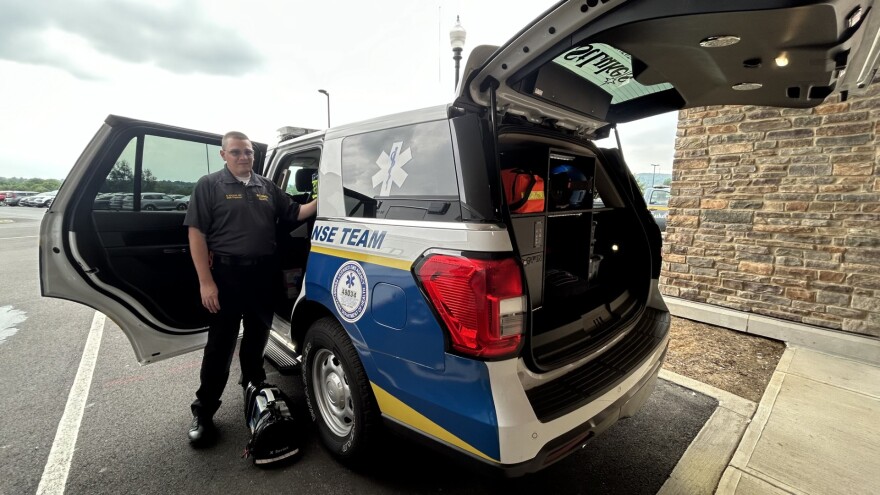EASTON, Pa. — Bridging the gap between first responders on the scene and medical professionals in the hospital.
That’s what St. Luke’s University Health Network aims to do with its new EMS physician response team.
"Collaboration between EMTs, paramedics and physicians is crucial for driving advancement in the field," said Dr. Ashley Woodrow, a St. Luke’s emergency medicine physician and its current EMS fellow.
"The more research we can do, the more we can learn from each other, the better our care for our patients in the field. Not only were we able to provide education to the crews on scene, but we're also able to bridge the gap with medications that they didn't necessarily have."Dr. Ashley Woodrow, a St. Luke’s emergency medicine physician and its current EMS fellow
"The more research we can do, the more we can learn from each other, the better our care for our patients in the field.
“Not only were we able to provide education to the crews on scene, but we're also able to bridge the gap with medications that they didn't necessarily have."
Woodrow said that being a former paramedic was the reason she wanted to join the St. Luke's EMS physician response team.
She said after that a conversation with the EMS fellowship director, she was immediately drawn to the program.
“He shared with me his vision for not only the fellowship program, but also for what we can do to provide this valuable service to the community and I was hooked since day one,” Woodrow said.
Dr. Bryan Wilson, the hospital system’s EMS Fellowship Director, said, “EMTs and paramedics have a significant ability to save lives and prevent morbidity and mortality, but by bringing a physician to the field, there's just expanded capabilities that come with that."
Wilson said the EMS fellowship is a year of training that physicians can do after they've completed their foundational training, known as a residency, where they can learn to become EMS medical directors.
Hitting the road
In addition to the fellowship program, St. Luke’s recently unveiled a physician's response vehicle to accompany it, bringing doctors out into the field to support the existing 911 emergency medical services within the community.
The SUV is equipped with most of what a doctor would need when encountering injury or illness outside of a hospital setting.
“That need for the paramedic to have to call the hospital to make those advanced level decisions doesn't need to happen because we'll be bedside with them."Dr. Ashley Woodrow, a St. Luke’s emergency medicine physician and its current EMS fellow
"By bringing a physician out of the hospital to the site of injury or illness, we have the ability to offer pretty much every service that would happen in the hospital at the bedside, that we would not necessarily be able to offer with a 911 Ambulance,” Wilson said.
Wilson said first responders on the scene can request an EMS physician response team when there’s a critical need, such as in cardiac arrest patients and severely injured trauma patients.
“We can do things such as rapid sequence intubation, we can bring blood products to the scene, we have advanced equipment, medication pumps and ultrasounds that in different parts of the country paramedics can certainly utilize," he said.
"But right now in Pennsylvania, those things are still under pilot for a lot of different areas.”
Wilson said his team and its vehicle also can offer stand-by care at large gatherings and festivals.
“That need for the paramedic to have to call the hospital to make those advanced level decisions doesn't need to happen because we'll be bedside with them,” Wilson said.
Although it’s been called a “mini-ER on wheels”, the physician's response vehicle does not transport patients.
If the doctor needs to ride with a patient to the hospital, he or she will go in an ambulance and retrieve the response vehicle later.
Improving communication
Woodrow said it’s a way to improve communication and services between those in the field and those in the hospital.
"As a physician, it's helpful to know not only what challenges our EMTs and paramedics are facing, [but] what do they want from us?" she said.
"I think it's a unique way to not only teach them, but also learn the intricacies of what they face on a day-to-day basis."Dr. Ashley Woodrow, a St. Luke’s emergency medicine physician and its current EMS fellow
"What, educationally, do they want from us? What services can we provide to them that they don't currently have, that would help them in their position?
“So I think it's a unique way to not only teach them, but also learn the intricacies of what they face on a day-to-day basis."
The specialized vehicle is a part of a partnership between St. Luke’s Emergency Medicine Department and Northampton County.
It's based out of St. Luke's Anderson Campus and was made possible through a $250,000 grant.


